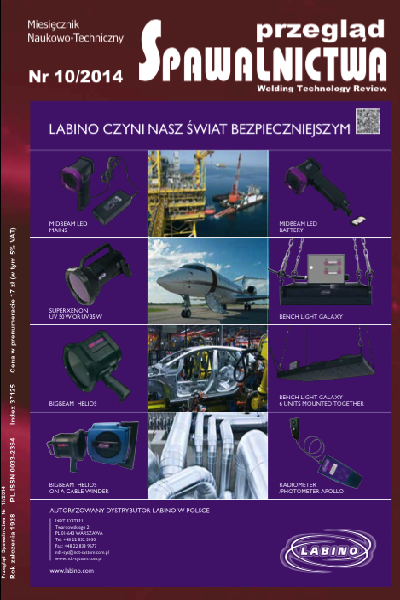Compaction and welding of copper-stranded wires by resistance heating; Brykietowanie końców lin miedzianych z wykorzystaniem nagrzewania oporowego
Main Article Content
Abstract
Resistance welding is widely recognised as a safe and economical welding method, benefits that also apply to compaction and welding of copper-stranded wires. Few published studies have documented this, but there has so far not been any scientifically established methodology in this regard. The works presented here cover compaction and welding of copper-stranded wires. The application-orient- ed studies present the bonding mechanism and examination of strands towards defining a general parameter window, giving users a very simple tool for parameterisation. We first examined the bonds using three-point bending tests first, and discovered a correlation between bending force and strand cross-section area. This led to the introduction of a factor with general validity. Compacting factor K is a simple factor for specifying strand compaction, involving the properties and therefore options for further processing such as in projection welding.
Streszczenie
Zgrzewanie oporowe jest szeroko postrzegane jako stosunkowo bezpieczna i ekonomiczna metoda spajania, która może być zastosowana do brykietowania końców przewodów, linek i taśm miedzianych. w literaturze trudno o kompleksowe opracowanie tego zagadnienia. Prezentowana praca obejmuje brykietyzację (zagęsz- czanie) końców przewodów (lin) miedzianych. Badania zorientowano na ujawnienie mechanizmu wiązania i badania właściwości zgrzein oraz na określenie okna parametrów, dając użytkownikom bardzo proste narzędzie do parametryzacji procesu. Właściwości zgrzein badano za pomocą testów zginania i ujawniono korelację pomiędzy siłą zginania a powierzchnią przekroju brykietu. wprowadzono współczynnik zagęszczenia K jako prosty czynnik określający zagęszczenie włókien.
Downloads
Article Details
Creative Commons CC BY 4.0 https://creativecommons.org/licenses/by/4.0/
Welding Technology Review (WTR) articles are published open access under a CC BY licence (Creative Commons Attribution 4.0 International licence). The CC BY licence is the most open licence available and considered the industry 'gold standard' for open access; it is also preferred by many funders. This licence allows readers to copy and redistribute the material in any medium or format, and to alter, transform, or build upon the material, including for commercial use, providing the original author is credited.
References
DIN EN 60228: 09/2005: Leiter für Kabel und isolierte Leitungen.
Zäh, M.: wirtschaftliche Fertigung mit Rapid-Technologien, Hanser Verlag, München, 2006.
